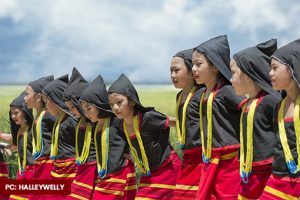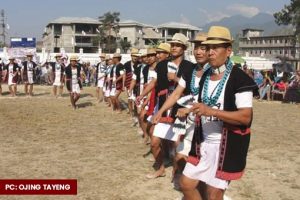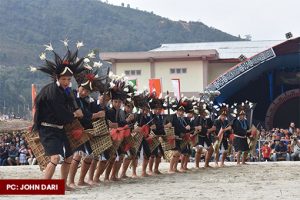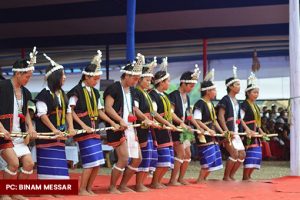The folk dances of the Adis


Communities of Arunachal Pradesh are known for their festive moods and vibrant dances. Every festival celebrated here, calls for the display of beautiful woven traditional attires, ornaments, songs and dances in unison within the tribes of the state. The dances performed not only uplift the charm of the festivals but also tell tales of heroic deeds that is passed down from generations to generations orally. The dances also showcase a better picture of their culture to the outside world. The Adi tribe forms one of the major indigenous tribal communities of Arunachal Pradesh and when it comes to celebrate festivals with fervor, they are not lagging behind. Here’s a glance into the beautiful folk dances of the Adis.
PONUNG

One of the most famous dances of the Adi community is the Ponung dance. Generally celebrated before the harvesting of the crops, the dance is performed to seek bumper healthy crops in the year as well as the healthy well-being of the village community. What makes it an interesting part of the celebration is that the performance is exclusive to the female folks of the community. The dance is guided by one man called a Miri. He holds a Yoksa which is a sword loosely fitted at the hilt and shakes it to make a rattling sound during the dance. The women gather around him in a beautifully arranged pattern repeating the same lines in the chorus initiated by him and move around in unison following the rhythm of the song. The delicate hand movements of the women and the traditional attires worn during the dance are mesmerising to look at. The women dancers wear a traditional piece of skirt called Gale, traditional top or blouse (Galup) and a Gale placed in a conical shape on the head along with beautiful ornaments like the Gol Pota (a small necklace made of coins and red beads), Madoli (a necklace made with black beads and a crescent shaped ending), Nok (a silver ornament that goes down from the shoulder to the hips), Tampilang (a long silver necklace made with coins), Sumbi/Humbi (a belt worn under the Galup), Sondorong (a long silver ornament made with beautiful patterns on it) and tadok (necklace made with colourful beads). Ponung is usually performed during the festive season of Solung or any other auspicious occasion.
Delong

Contrary to Ponung, the Delong dance is exclusive to menfolk of the Adi community of Arunachal Pradesh. It is generally performed during the Etor festival of the Adis in a Dere which means a community hall in a village. The festival of Etor can be termed as a community fence festival where people make or mend fences around the agricultural lands of the villages to protect it from the invasion of roaming domestic animals. After the work in a day or two, males from the village gather in the Dere to perform the dance. Like Ponung, the dance is led by a Miri who sings traditional hymns that is backed by the performing men from the village. It is an energetic dance performed with ardent enthusiasm by the menfolk of the Adi community.
Tapu

The Tapu is a war dance of the Adis that was recently given the national spotlight when Tapu performers from Arunachal Pradesh participated in the national parade held at Rajpath, Delhi on the auspicious occasion of Republic Day of India 2022. Tapu takes place during the festival of Unying Aran. This energetic war dance is performed by menfolk wearing the war costumes with swords and shields. Taking an aggressive war fighting stance, the Adi men dance in a long line shouting triumphant war cries. The performers re-enact the old age war details and the old tales of heroic deeds with war cries filled with enthusiasm. The war dance of Tapu is performed in order to ward off evil spirits from the village.
Yakjong

Also celebrated during the Unying Aran festival of the Adis, Yakjong doesn’t have any age or gender restrictions. This can be performed by men, women and even the children of the Adi community. The performers visit houses in the village during the festive season and it is believed that welcoming the Yakjong performers herald bumper harvest into the house hosting them. The performers carry sticks with designs made on them. This is a type of dance that is open to possibilities in the way it is preferred by the performers to perform. The dance is full of positivity and it is meant to shower blessings on the houses welcoming the performers as well as spread the joy of Aran to the common masses. The performers are often seen off by the host family with either money or some eatables.
It is important to note that the folk dances are not mere dances of merriment. They reflect the ethnic diversity and the richness of cultural heritage galore in Arunachal Pradesh. They also keep alive the age old traditions of telling tales of the pasts to the younger generations to carry on. Passing on the rich possession of indigenous cultural heritage is important to preserve the ethnic identity of the tribal communities that might die out if there is a gap of communication in between. Folk dances serve a salient purpose in this matter.


